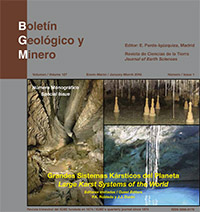A model of karst systems of the Usturt plateau (Middle Asia)
DOI:
https://doi.org/10.21701/bolgeomin.127.1.016Keywords:
stochastic processes, karst and suffusion depressions, uniform plateau siteAbstract
The issues relating to the structure and development of desert karst is currently one of the least studied problems. The goal of the research efforts presented in this paper was to create a model of karst systems in the Usturt Plateau and, primarily, of the systems formed by the prevailing numerous surface karst landforms. The model is based on the following main assumptions: the process of emergence of the karst phenomena is probabilistic and occurs independently at non-intersecting sites; the probability of emergence of one depression at a reference site depends only on its area. The increase of the dimensions of a karst landform is a random process that occurs independently of other karst landforms, its speed is governed by random factors, and it is directly proportionate to the existing dimensions of the landform. The model does not assume constancy of climatic characteristics. The testing was conducted at several reference sites of the Usturt Plateau. The research allowed us to reach the following conclusions: the karst depressions of the Usturt Plateau, which are the typical forms of desert karst, are governed by the Poisson distribution of their centres and by the lognormal distribution of their dimensions, similar to the karst depressions in a humid climate. The results may be used in assessments of karst hazard for linear and areal structures, as well as for small-dimensional structures.
Downloads
References
Chikishev, A.G. 1971. Karst of Usturt and Mangishlak. “Earth Studies” Vol. 9 MSU Press.
Goltz, S.I., M.I. Epifanov. 1965. Karst depressions of Central and Eastern Usturt. In book: Karst types in the USSR. Nauka, Moscow, 62-67.
Karlin, S. 1971. Fundamentals of the theory of stochastic processes. Mir, Moscow. 536 pp.
Kleiner, Yu.M. 1962. Mangyshlak and Usturt depressions. Priroda, Nº 2
Koroljuk, V.S., N.I. Portenko, A.V. Skorokhod, et al 1985. Handbook of probability theory and mathematical statistics. Nauka, Moscow, 640 pp.
Kuznetsov, Yu.Ya. 1965. Usturt Plateau as an example of a karst desert area. In: Karst types in the USSR. Nauka, Moscow, 56-62.
McConnell H., Horn J.M. 1972. Probabilities of surface Karst. In: Spatial Analysis in Geomorphology. Ed. by Chorley R.L.
Momotov, N.F. 1953. Plant communities of Usturt Plateau. AN UzSSR Press. Tashkent. 136 pp.
Tolmachev, V.V. 1971. On the law of the distribution of diameters of karst sinkholes. In book: Mathematical methods in geography. KSU Press. Kazan 111-113.
Tolmachev, V.V., F. Royter. Engineering karst studies. Moscow. 1990.
Victorov, S.V. 1971. Desert Usturt and aspects of its development. Nauka, MOIP Press. 134 pp.
Victorov, A.S. 1979. Quantitative parameters of the structure of karst and suffusion landscape patterns and their indication value. In: The importance of bioindication for land reclamation, MFGO. Moscow.
Victorov, A.S. 1998. Mathematical morphology of landscape. Tratek, Moscow, 180 pp.
Victorov, A.S. 2006. Main issues of mathematical morphology of landscapes. Nauka. Moscow. 254 pp.
Downloads
Published
How to Cite
Issue
Section
License
Copyright (c) 2024 Consejo Superior de Investigaciones Científicas (CSIC)

This work is licensed under a Creative Commons Attribution 4.0 International License.
© CSIC. Manuscripts published in both the print and online versions of this journal are the property of the Consejo Superior de Investigaciones Científicas, and quoting this source is a requirement for any partial or full reproduction.
All contents of this electronic edition, except where otherwise noted, are distributed under a Creative Commons Attribution 4.0 International (CC BY 4.0) licence. You may read the basic information and the legal text of the licence. The indication of the CC BY 4.0 licence must be expressly stated in this way when necessary.
Self-archiving in repositories, personal webpages or similar, of any version other than the final version of the work produced by the publisher, is not allowed.
Funding data
Russian Science Foundation
Grant numbers 14-17-00357















